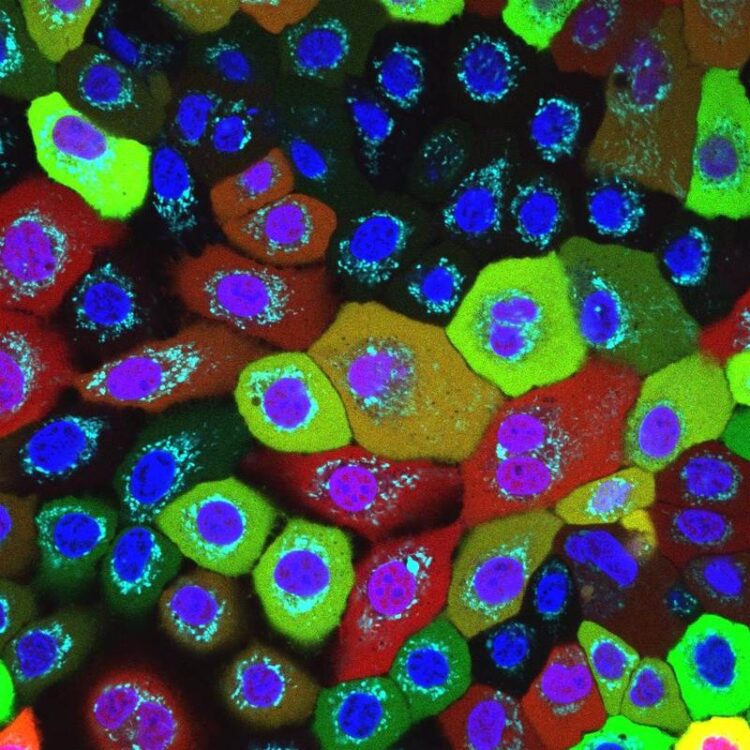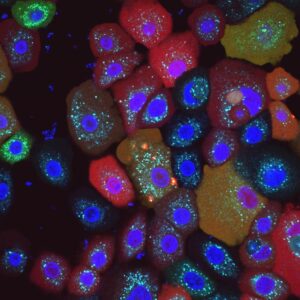New intracellular “smoke detector” discovered

Human skin cells with "healthy" mitochondria (light blue): The NLRP10 "smoke detector" (yellow-green) is distributed over the entire contents of the cell, apart from the nucleus (blue-violet).
Image: Kim S. Robinson/Skin Research Institute Singapore
Researchers at the Universities of Bonn and Singapore have discovered a new intracellular “smoke detector.” The sensor warns of damage to the mitochondria – the microscopic power plants that supply the cell with energy. If it does not function properly, chronic skin diseases can result. The sensor may also be important for unimpaired heart and bowel function. The results have now been published in the journal Nature Immunology.

Image: Kim S. Robinson/Skin Research Institute Singapore
Every cell in the body has numerous sensors that monitor its function. Some sound the alarm after a virus attack, for instance; others kick in when any kind of damage threatens the cell’s survival. “We have now discovered that a molecule called NLRP10 also acts as a sensor,” explains Prof. Dr. Eicke Latz, head of the Institute of Innate Immunity at the University Hospital Bonn. “This was completely unknown until now.”
Figuratively speaking, NLRP10 detects when the mitochondria in the cell start to smoke due to some malfunction. These are the microscopic power plants that provide the energy for cellular functions. As soon as an NLRP10 sensor detects damage to mitochondria, it sets off a complicated process. This creates a so-called inflammasome, a complex molecular machine. Its activity ultimately causes the cell to perish and be disposed of by summoned immune cells.
Fire alarm prevents long-lasting smoldering fire
“This process is hugely important,” explains Latz, who is also the spokesperson for the Cluster of Excellence ImmunoSensation2 and a member of the Transdisciplinary Research Area “Life and Health” at the University of Bonn. This is because the inflammasome ensures that the fire is stamped out straight away, which prevents a prolonged smoldering fire that would damage other parts of the tissue. “Disruption of this mechanism can result in chronic inflammation,” the researcher emphasizes. “Killing cells with mitochondrial defects may sound drastic. Ultimately, however, this step prevents more serious consequences.”
Not all cells in the body have an NLRP10 sensor. The “fire detector” occurs primarily in the outermost skin layer, the stratum granulosum. The skin is directly exposed to environmental stimuli such as UV radiation, but also pathogens. This could potentially result in accumulated damage. The mechanism ensures that affected cells are effectively disposed of. “If a mutation causes the NLRP10 sensor to malfunction, this can result in a chronic skin inflammation called atopic dermatitis,” explains Dr. Tomasz Próchnicki, who performed an important part of the experiments for his doctorate in Latz’s research group.
Sensor is also found in the intestinal wall and heart
Large quantities of NLRP10 are also found in the intestinal wall cells. These also have regular contact with pathogens and potentially harmful substances. Another organ in which the sensor can be detected is the heart: It is particularly dependent on a well-functioning energy supply. This may make it especially important to quickly kill and replace cells with defective mitochondria.
The study may potentially also open up new therapeutic perspectives. “It is conceivable to specifically modulate the NLRP10 sensor using certain substances in order to stimulate the formation of inflammasomes,” Latz explains. “This approach might enable chronic skin diseases to be better controlled.”
Participating institutions and funding:
In addition to the University Hospital and the University of Bonn, the Skin Research Institute of Singapore, the Technical University of Dresden and the University of Hohenheim were involved in the work. The study was funded by the German Research Foundation (DFG), by EU funds under the European Union’s Horizon 2020 program, by the Helmholtz Association, and by the Nation Research Foundation in Singapore.
Wissenschaftliche Ansprechpartner:
Prof. Dr. Eicke Latz
Institute of Innate Immunity of the University of Bonn
Co-speaker of the Cluster of Excellence “ImmunoSensation”
Tel. +49 228 287-51239
E-mail: eicke.latz@uni-bonn.de
Originalpublikation:
Tomasz Próchnicki et al.: Mitochondrial damage activates the NLRP10 inflammasome; Nature Immunology; DOI: 10.1038/s41590-023-01451-y; https://www.nature.com/articles/s41590-023-01451-y
Media Contact
All latest news from the category: Health and Medicine
This subject area encompasses research and studies in the field of human medicine.
Among the wide-ranging list of topics covered here are anesthesiology, anatomy, surgery, human genetics, hygiene and environmental medicine, internal medicine, neurology, pharmacology, physiology, urology and dental medicine.
Newest articles
Faster, more energy-efficient way to manufacture an industrially important chemical
Zirconium combined with silicon nitride enhances the conversion of propane — present in natural gas — needed to create in-demand plastic, polypropylene. Polypropylene is a common type of plastic found…

Energy planning in Ghana as a role model for the world
Improving the resilience of energy systems in the Global South. What criteria should we use to better plan for resilient energy systems? How do socio-economic, technical and climate change related…

Artificial blood vessels could improve heart bypass outcomes
Artificial blood vessels could improve heart bypass outcomes. 3D-printed blood vessels, which closely mimic the properties of human veins, could transform the treatment of cardiovascular diseases. Strong, flexible, gel-like tubes…





















